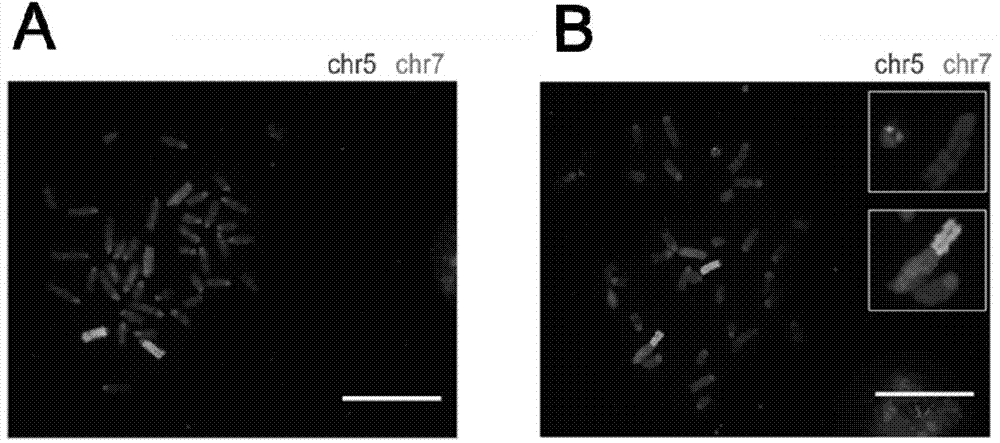Method for constructing chromosome translocation stem cell and animal model by CRISPR-Cas9 technology
A technology of chromosomal translocation and animal model, applied in the field of animal model
- Summary
- Abstract
- Description
- Claims
- Application Information
AI Technical Summary
Problems solved by technology
Method used
Image
Examples
Embodiment 1
[0071] Example 1: Isolation, culture and passage of mouse embryonic stem cells (mESCs).
[0072] According to the method reported in the literature, the specific method can be referred to: Czechanski, A., et al., Derivation and characterization of mouse embryonic stem cells from permissive and nonpermissive strains. Nat Protoc, 2014.9(3): p. 559-74. After the mouse embryonic stem cells are isolated, they are cultured as follows:
[0073] In 0.1% gelatin-coated petri dishes or plates, the medium is mES medium and placed in 5% CO 2 , 37 ℃ cell culture incubator; the mES medium contains 1% non-essential amino acids (Invitrogen), 10% fetal bovine serum (HyClone), 0.1mM β-mercaptoethanol (Invitrogen), 2mM GlutaMax (Invitrogen), And 100 units / ml of GMEM medium (Sigma, G5414) of leukemia inhibitory factor.
[0074] When the cultured mESCs clones and clones are about to fuse, they need to be passaged, usually every 2-3 days. The specific method is:
[0075] 1. Remove the medium, and fine it ...
Embodiment 2
[0081] Example 2: Design and construct gRNA expression vectors targeting mouse chromosomes 7 and 5.
[0082] This example aims to construct a translocation between mouse chromosome 7 and chromosome 5 in embryonic stem cells.
[0083] The designed translocation site of chromosome 7 is located at the site of GSK3a gene, specifically: chr7:25235652-25235624, and its site sequence is: 25235652- GATTGGTAATGGCTCATT CGG-25235632, the design recognition site of its gRNA is: GATTGGTAATGGCTCATT (SEQ ID NO:1)
[0084] The designed translocation site of chromosome 5 is located at the site of CDX2 gene, specifically: chr5:
[0085] 147306976-147306947, its locus sequence is: 147306976- GTGAGCTACCTTCTGGACA AGG-147306955, the design recognition site of its gRNA is: GTGAGCTACCTTCTGGACA (SEQ ID NO: 2)
[0086] After the design is completed, a DNA synthesis company is entrusted to synthesize the expressed DNA sequence of gRNA-1 for chromosome 7 according to sequence 5, and the expression DNA sequence ...
Embodiment 3
[0087] Example 3: Inducing a specific site translocation between chromosome 7 and chromosome 5 in mouse embryonic stem cells by CRISPR / Cas9 technology.
[0088] 1. Cell culture and transfection
[0089] Mouse embryonic stem cells (mESCs) are divided into two groups, one group is an experimental group and the other is a control group. They are cultured in mES medium and placed in a 37°C, 5% carbon dioxide incubator. When the cell density of the two groups reached about 50%, Lipofectamine2000 reagent (Invitrogene, USA) was used for transfection according to the steps and reagent ratios in the transfection reagent instructions. The experimental group was transfected with gRNA-1, gRNA-2 expression vector, and Cas9 expression vector (purchased from Addgene Plasmid ID: 41815), and the control group was only transfected with Cas9 expression vector.
[0090] 2. Chromosome specific site translocation identification
[0091] (1) PCR to identify chromosomal translocations at specific sites
[00...
PUM
 Login to View More
Login to View More Abstract
Description
Claims
Application Information
 Login to View More
Login to View More - R&D
- Intellectual Property
- Life Sciences
- Materials
- Tech Scout
- Unparalleled Data Quality
- Higher Quality Content
- 60% Fewer Hallucinations
Browse by: Latest US Patents, China's latest patents, Technical Efficacy Thesaurus, Application Domain, Technology Topic, Popular Technical Reports.
© 2025 PatSnap. All rights reserved.Legal|Privacy policy|Modern Slavery Act Transparency Statement|Sitemap|About US| Contact US: help@patsnap.com



